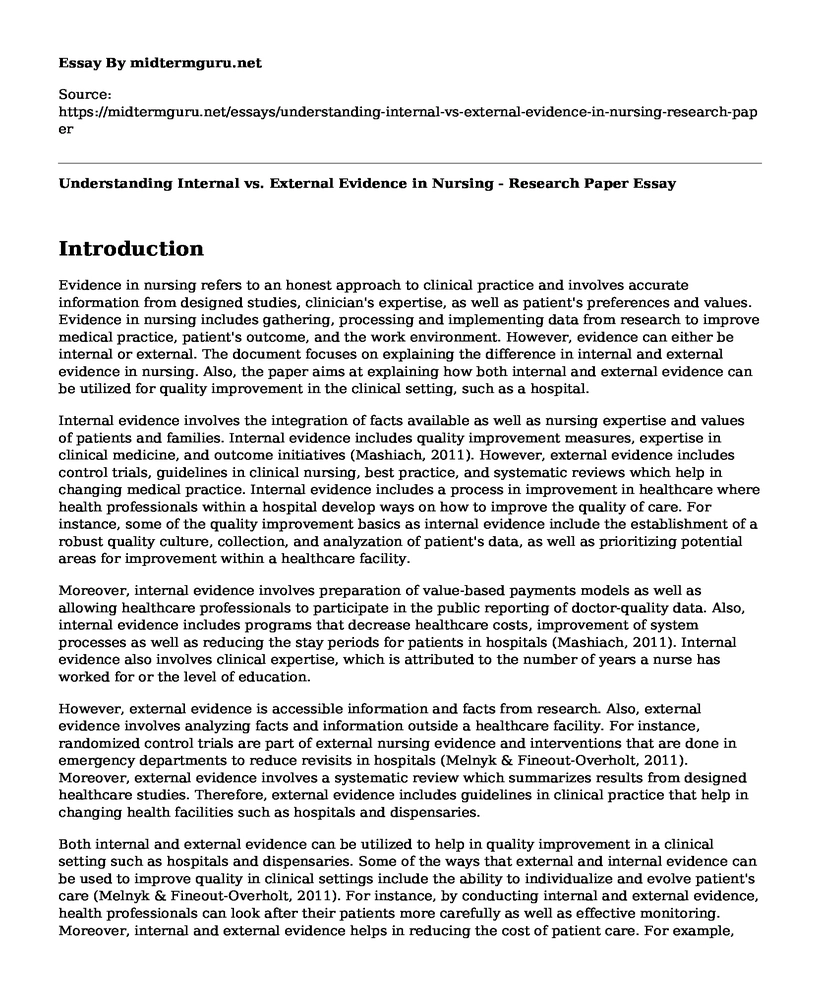Introduction
Evidence in nursing refers to an honest approach to clinical practice and involves accurate information from designed studies, clinician's expertise, as well as patient's preferences and values. Evidence in nursing includes gathering, processing and implementing data from research to improve medical practice, patient's outcome, and the work environment. However, evidence can either be internal or external. The document focuses on explaining the difference in internal and external evidence in nursing. Also, the paper aims at explaining how both internal and external evidence can be utilized for quality improvement in the clinical setting, such as a hospital.
Internal evidence involves the integration of facts available as well as nursing expertise and values of patients and families. Internal evidence includes quality improvement measures, expertise in clinical medicine, and outcome initiatives (Mashiach, 2011). However, external evidence includes control trials, guidelines in clinical nursing, best practice, and systematic reviews which help in changing medical practice. Internal evidence includes a process in improvement in healthcare where health professionals within a hospital develop ways on how to improve the quality of care. For instance, some of the quality improvement basics as internal evidence include the establishment of a robust quality culture, collection, and analyzation of patient's data, as well as prioritizing potential areas for improvement within a healthcare facility.
Moreover, internal evidence involves preparation of value-based payments models as well as allowing healthcare professionals to participate in the public reporting of doctor-quality data. Also, internal evidence includes programs that decrease healthcare costs, improvement of system processes as well as reducing the stay periods for patients in hospitals (Mashiach, 2011). Internal evidence also involves clinical expertise, which is attributed to the number of years a nurse has worked for or the level of education.
However, external evidence is accessible information and facts from research. Also, external evidence involves analyzing facts and information outside a healthcare facility. For instance, randomized control trials are part of external nursing evidence and interventions that are done in emergency departments to reduce revisits in hospitals (Melnyk & Fineout-Overholt, 2011). Moreover, external evidence involves a systematic review which summarizes results from designed healthcare studies. Therefore, external evidence includes guidelines in clinical practice that help in changing health facilities such as hospitals and dispensaries.
Both internal and external evidence can be utilized to help in quality improvement in a clinical setting such as hospitals and dispensaries. Some of the ways that external and internal evidence can be used to improve quality in clinical settings include the ability to individualize and evolve patient's care (Melnyk & Fineout-Overholt, 2011). For instance, by conducting internal and external evidence, health professionals can look after their patients more carefully as well as effective monitoring. Moreover, internal and external evidence helps in reducing the cost of patient care. For example, through adequate external evidence, nurses and other health workers can develop ways of treating their patients at a cost-friendly rate. Both internal and external evidence help in the enhancement and improvement of the expertise of health professionals. Through comprehensive research, medical professionals can improve their knowledge and skills and thus help in quality improvement in a clinical setting. Conclusively, Nursing evidence help in the advancement of healthcare where all methods of care are based on credible information and facts thus help in quality improvement in a clinical setting,
References
Mashiach Eizenberg, M. (2011). Implementation of evidencebased nursing practice: nurses' personal and professional factors?. Journal of advanced nursing, 67(1), 33-42. Retrieved from https://scholar.google.com/scholar?hl=en&as_sdt=0%2C5&q=Internal+evidence+in+nursing&btnG=#d=gs_cit&u=%2Fscholar%3Fq%3Dinfo%3ATQDZCYJp6UsJ%3Ascholar.google.com%2F%26output%3Dcite%26scirp%3D4%26hl%3Den
Melnyk, B. M., & Fineout-Overholt, E. (Eds.). (2011). Evidence-based practice in nursing & healthcare: A guide to best practice. Lippincott Williams & Wilkins. https://scholar.google.com/scholar?hl=en&as_sdt=0%2C5&q=Internal+evidence+in+nursing&btnG=#d=gs_cit&u=%2Fscholar%3Fq%3Dinfo%3ATQDZCYJp6UsJ%3Ascholar.google.com%2F%26output%3Dcite%26scirp%3D4%26hl%3Den
Cite this page
Understanding Internal vs. External Evidence in Nursing - Research Paper. (2023, Jan 25). Retrieved from https://midtermguru.com/essays/understanding-internal-vs-external-evidence-in-nursing-research-paper
If you are the original author of this essay and no longer wish to have it published on the midtermguru.com website, please click below to request its removal:
- Questions on Public Health: Pregnancy Duration and Air Quality Values
- Essay Example on Holistic Nursing
- Paper Example on Peplau's Theory of Interpersonal Relations
- Paper Example on Nursing: Servant Leadership Model
- Essay Sample on Pneumonia
- 2020 Cardiovascular Disease Stats: US Death Rates Remain High - Essay Sample
- Scope of Practice for APRNs in Georgia: FNP Consensus Model & Prescribing - Essay Sample







